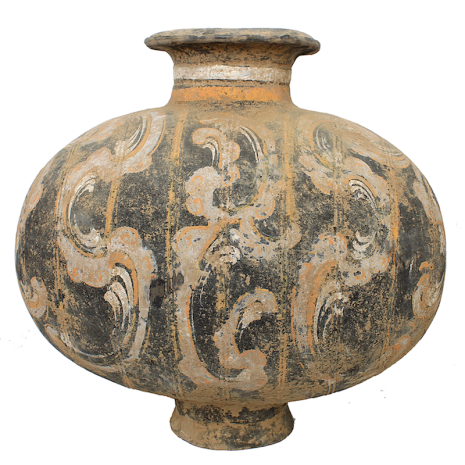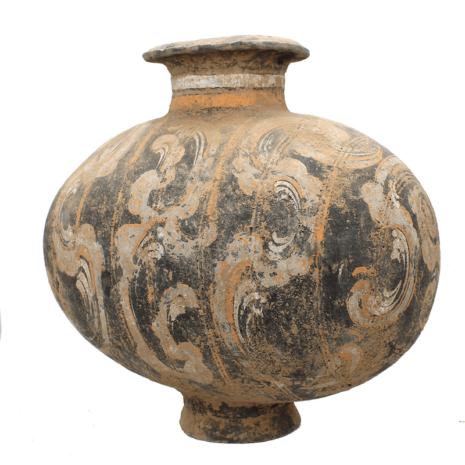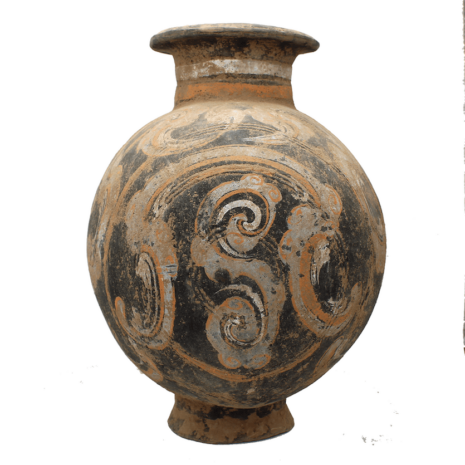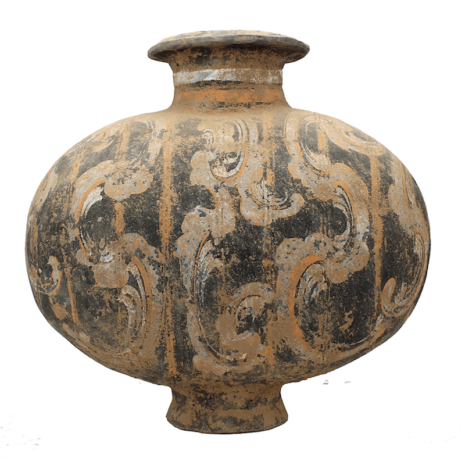Han Dynasty Cocoon Jar with Cloud Designs, China
Original price was: $2,100.00.$1,700.00Current price is: $1,700.00.
H: 11.75” W: 12.25” CALL 213-568-3030 OR EMAIL [email protected] FOR SHIPPING.
Families placed cocoon jars with auspicious designs containing magical mixtures of mulberry leaves in tombs for souls of the departed to drink for a transformative afterlife. Ovoid shaped, it rests on a trumpet-shaped foot decorated with elegant cloud scrolls and circular “eye” motifs.
Description
Unglazed pottery cocoon jars were used in the Han dynasty as mingqi ancestral items to place in tombs to revere, honor and comfort the deceased and fulfill Chinese duties of filial piety. Wheel made with seamless joined parts to form their thin-walled ovoid shape, they were designed to resemble a silkworm’s cocoon. The silk industry was so significant in amassing wealth through international trade that its influence impacted even Chinese Taoist and Confucian beliefs. Alchemists examined silkworms’ metamorphoses and concluded that mulberry leaves that produced their transformation would also have life-prolonging properties; thus, ingesting liquids from leaves or ashes could also extend life indefinitely. The mulberry concoction soon became accepted as an elixir for immortality. Jars were deigned their reflect importance of silkworms in their cocoon shape, patterns and contents. Jars like this were decorated with clouds scroll to evoke a state free from time and earthly limits with full access to the otherworld. These concepts were seen in Han poetry of the afterlife in which departed souls could soar upward to the realm of the immortals in “cloud chariots”. Ovoid in shape to resemble a silkworm cocoon, this jar rests on a small trumpet-shaped foot and has a narrow neck and wide mouth. Painted after firing its vertical bands divide the jar into panels, swirling cloud scrolls and circular “eye” motifs at each end. Families placed cocoon jars with auspicious designs containing magical mixtures of mulberry leaves in tombs for the souls of the departed to drink for a transformative afterlife.
Additional information
| Place of Origin | China |
|---|---|
| Period | Ancient, Han Dynasty |
| Date | 206 BCE-220 CE |
| Materials and Technique | Terracotta |
| Dimensions (inches) | Ht: 11.75” W:12.25” D: 7.5” |
| Dimensions (metric) | Ht: 29.84cm W: 31.11cm D: 19.05 |
| Weight | 7lbs 5oz |
| Condition | Very good, wear consistent with age and use/no restorations/repairs |
| Item Number | 16015UHEM |
| Shipping Box Size | Oversized. Call 213-568-3030 or email [email protected] for shipping. |








